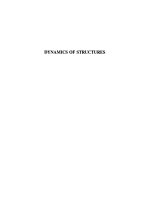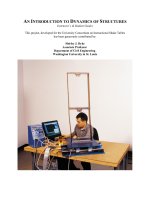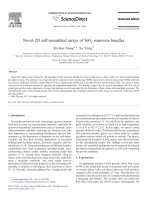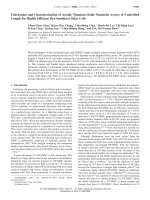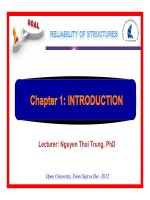Arrays of structures
Bạn đang xem bản rút gọn của tài liệu. Xem và tải ngay bản đầy đủ của tài liệu tại đây (245.73 KB, 26 trang )
6.087 Lecture 6 – January 19, 2010
Review
User defined datatype
Structures
Unions
Bitfields
Data structure
Memory allocation
Linked lists
Binary trees
1
Review: pointers
•
Pointers: memory address of variables
•
’&’ (address of) operator.
•
Declaring:
int x=10; int ∗ px= &x;
•
Dereferencing:
∗px=20;
Pointer arithmetic:
•
•
sizeof()
•
incrementing/decrementing
•
absolute value after operation depends on pointer datatype.
1
Review: string.h
•
String copy: strcpy(),strncpy()
•
Comparison: strcmp(),strncmp()
•
Length: strlen()
•
Concatenation: strcat()
•
Search: strchr(),strstr()
2
Searching and sorting
Searching
•
Linear search: O(n)
•
Binary search: O(logn). The array has to be sorted first.
Sorting
•
Insertion sort: O(n
2
)
•
Quick sort: O(n log n)
3
6.087 Lecture 6 – January 19, 2010
Review
User defined datatype
Structures
Unions
Bitfields
Data structure
Memory allocation
Linked lists
Binary trees
4
Structure
Definition: A structure is a collection of related variables (of
possibly different types) grouped together under a single name.
This is a an example of composition–building complex
structures out of simple ones.
Examples:
str u ct employee
str u ct p o i n t {
{
char fname [ 1 0 0 ] ;
i n t x ; char lname [ 1 0 0 ] ;
i n t y ; i n t age ;
} ; } ;
/ ∗ n o t i c e the ; a t the end ∗ / / ∗ members o f d i f f e r e n t
type ∗ /
4
Structure
•
struct
defines a new datatype.
•
The name of the structure is optional.
struct {...} x,y,z;
The variables declared within a structure are called its
•
members
•
Variables can be declared like any other built in data-type.
struct point ptA;
•
Initialization is done by specifying values of every member.
struct point ptA={10,20};
•
Assignment operator copies every member of the structure
(be careful with pointers).
5
Structure (cont.)
More examples:
str u ct t r i a n g l e str u ct chain_element
{
{
str u ct p o i n t ptA ;
i n t data ;
str u ct p o i n t ptB ;
str u ct chain_element ∗ next
str u ct p o i n t ptC ;
} ;
} ;
/ ∗ members can be
/
∗ members can be s t r u c t u r e s ∗ / s e l f r e f e r e n t i a l ∗ /
6
Structure (cont.)
•
Individual members can be accessed using ’.’ operator.
struct point pt={10,20}; int x=pt.x; int y=pt.y;
•
If structure is nested, multiple ’.’ are required
str u ct rectangle
{
str u ct p o i n t t l ; /
∗ top l e f t ∗ /
str u ct p o i n t br ; /
∗ bot r i g h t ∗ /
} ;
str u ct rectangle r e c t ;
i n t t l x = r e c t . t l . x ; /
∗ nested ∗ /
i n t t l y = r e c t . t l . y ;
7
Structure pointers
•
Structures are copied element wise.
•
For large structures it is more efficient to pass pointers.
void foo(struct point ∗ pp); struct point pt ; foo(&pt)
•
Members can be accesses from structure pointers using
’->’ operator.
str u ct p o i n t p = { 1 0 , 2 0 };
str u ct p o i n t
∗ pp=&p ;
pp
−>x = 10 ; / ∗ changes p . x ∗ /
i n t y= pp
−>y ; / ∗ same as y=p . y ∗ /
Other ways to access structure members?
str u ct p o i n t p = { 1 0 , 2 0 };
str u ct p o i n t ∗ pp=&p ;
( ∗ pp ) . x = 10; / ∗ changes p . x ∗ /
i n t y= ( ∗ pp ) . y ; / ∗ same as y=p . y ∗ /
why is the () required?
8

